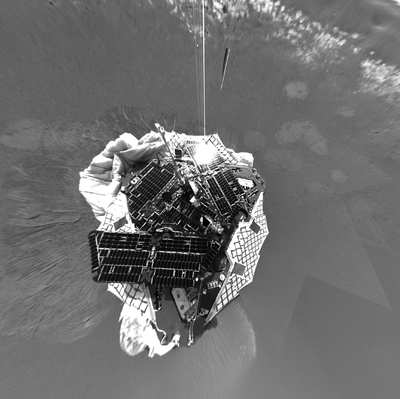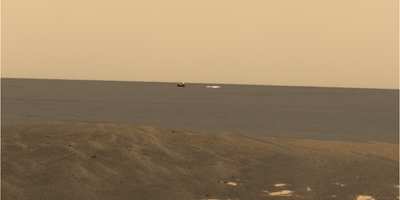Science journal set to publish 11 reports on Opportunity's
discovery
The most dramatic findings so far from NASA's twin Mars rovers
-- telltale evidence for a wet and possibly habitable environment
in the arid planet's past -- passed rigorous scientific scrutiny
for publication in a major research journal.

Eleven reports by 122 authors in Friday's issue of the journal
Science present results from Opportunity's three-month prime
mission, fleshing out headline discoveries revealed earlier.
Opportunity bounced to an airbag-cushioned landing on January
24. It is exploring a region called Meridiani Planum, halfway
around Mars from where its twin, Spirit, landed three weeks
earlier. Sedimentary rocks Opportunity examined, "clearly preserve
a record of environmental conditions different from any on Mars
today," report 50 rover-team scientists led by Dr. Steve Squyres of
Cornell University, Ithaca (NY) and Dr. Ray Arvidson of Washington
University, St. Louis (MO).
"Liquid water was once intermittently present at the martian
surface at Meridiani, and at times it saturated the subsurface.
Because liquid water is a key prerequisite for life, we infer
conditions at Meridiani may have been habitable for some period of
time in martian history," according to Squyres, Arvidson and other
co-authors.

"Formal review and publication this week of these amazing
discoveries further strengthens the need for continued exploration
by orbiters, surface robots, sample-return missions and human
explorers. There are more exciting discoveries awaiting us on the
red planet," said Dr. Michael Meyer, chief scientist for Mars
exploration at NASA Headquarters, Washington (DC).
Opportunity and Spirit have driven a combined 5.75 kilometers
(3.57 miles), nearly five times their mission-success goal. They
continue in good health after operating more than three times as
long as the three-month prime missions for which they were
designed.
NASA's rover team makes the resulting scientific discoveries
available quickly to the public and the science community. One type
of evidence that Meridiani was wet is the composition of rocks
there.
The rocks have a high and variable ratio of bromine to chlorine;
indicating "the past presence of large amounts of water," write Dr.
Rudi Rieder and Dr. Ralf Gellert of Max-Planck-Institute for
Chemistry, Mainz, Germany, and co-authors. Their paper and another
by Dr. Phil Christensen of Arizona State University, Tempe (AZ),
and collaborators report an abundance of sulfur-rich minerals in
the rocks, another clue to a watery past. Clinching the case is
identification of a hydrated iron-sulfate salt called jarosite in
the rocks, as reported by Dr. Goestar Klingelhoefer of the
University of Mainz, and Dr. Richard Morris of NASA's Johnson Space
Center, Houston (TX), and co-authors.

Structures within the rocks add more evidence according to Dr.
Ken Herkenhoff of the U.S. Geological Survey, Flagstaff (AZ), and
co-authors. Plentiful cavities, about the size of shirt buttons,
indicate crystals formed inside the rocks then dissolved. Minerals
carried by water formed peppercorn-size gray spheres, nicknamed
"blueberries," that are embedded in the rocks. Certain angled
patterns of fine layers in some rocks tell experts a flowing body
of surface water shaped the sediments that became the rocks.
Several characteristics of the rocks suggest water came and went
repeatedly, as it does in some shallow lakes in desert environments
on Earth. That fluctuation, plus the water's possible high acidity
and saltiness, would have posed challenges to life, but not
necessarily insurmountable ones, according to researchers. If life
ever did exist at Meridiani, the type of rocks found there could be
good preservers of fossils, according to Squyres, Dr. John
Grotzinger of the Massachusetts Institute of Technology, Cambridge
(MA), and co-authors.
 Unfortunate... ANN/SportPlane Resource Guide Adds To Cautionary Advisories
Unfortunate... ANN/SportPlane Resource Guide Adds To Cautionary Advisories ANN FAQ: Turn On Post Notifications
ANN FAQ: Turn On Post Notifications ANN's Daily Aero-Term (04.29.24): Visual Approach Slope Indicator (VASI)
ANN's Daily Aero-Term (04.29.24): Visual Approach Slope Indicator (VASI) ANN's Daily Aero-Term (04.28.24): Airport Marking Aids
ANN's Daily Aero-Term (04.28.24): Airport Marking Aids ANN's Daily Aero-Linx (04.28.24)
ANN's Daily Aero-Linx (04.28.24)





